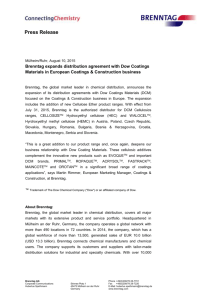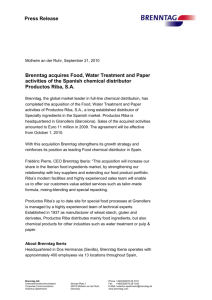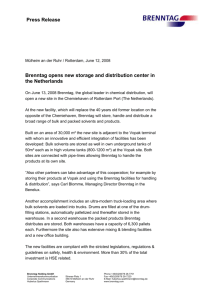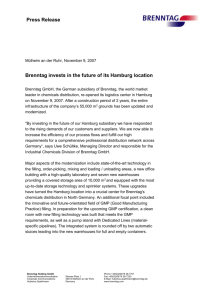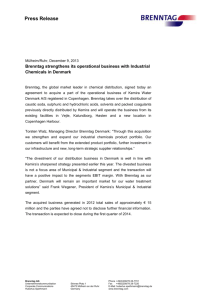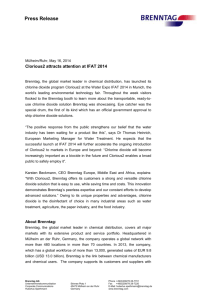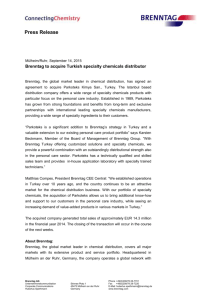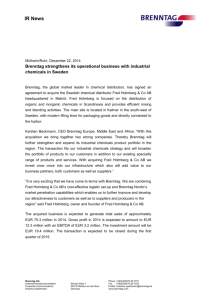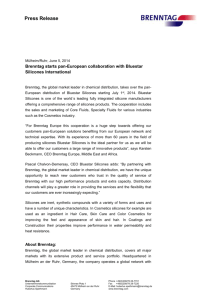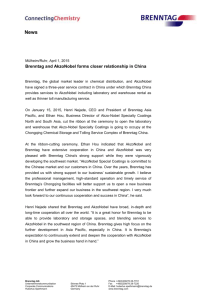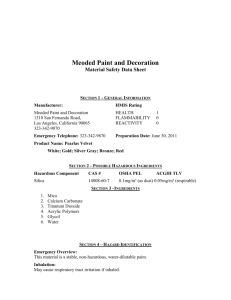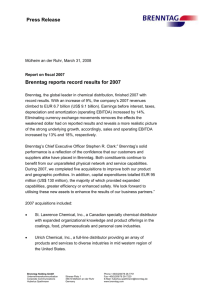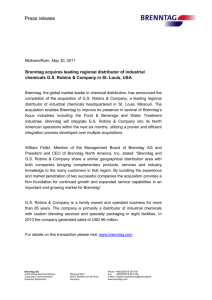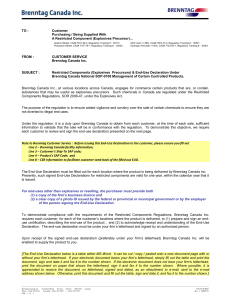MSDS - Shopify
advertisement
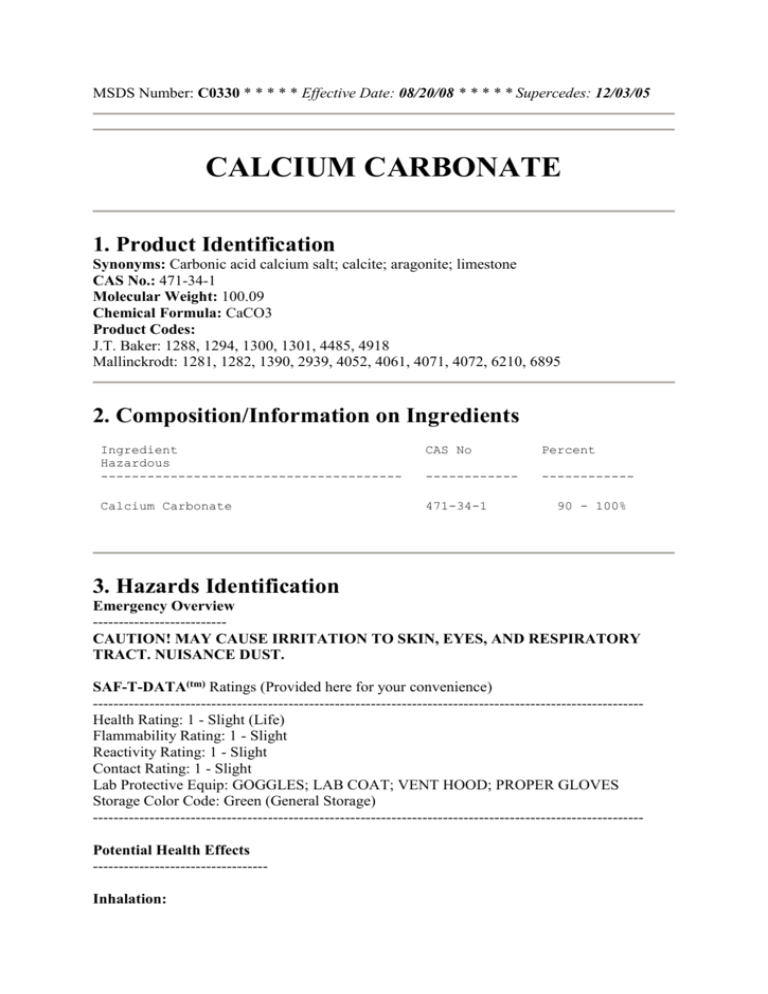
MSDS Number: C0330 * * * * * Effective Date: 08/20/08 * * * * * Supercedes: 12/03/05 CALCIUM CARBONATE 1. Product Identification Synonyms: Carbonic acid calcium salt; calcite; aragonite; limestone CAS No.: 471-34-1 Molecular Weight: 100.09 Chemical Formula: CaCO3 Product Codes: J.T. Baker: 1288, 1294, 1300, 1301, 4485, 4918 Mallinckrodt: 1281, 1282, 1390, 2939, 4052, 4061, 4071, 4072, 6210, 6895 2. Composition/Information on Ingredients Ingredient Hazardous --------------------------------------- CAS No Percent ------------ ------------ Calcium Carbonate 471-34-1 90 - 100% 3. Hazards Identification Emergency Overview -------------------------CAUTION! MAY CAUSE IRRITATION TO SKIN, EYES, AND RESPIRATORY TRACT. NUISANCE DUST. SAF-T-DATA(tm) Ratings (Provided here for your convenience) ----------------------------------------------------------------------------------------------------------Health Rating: 1 - Slight (Life) Flammability Rating: 1 - Slight Reactivity Rating: 1 - Slight Contact Rating: 1 - Slight Lab Protective Equip: GOGGLES; LAB COAT; VENT HOOD; PROPER GLOVES Storage Color Code: Green (General Storage) ----------------------------------------------------------------------------------------------------------Potential Health Effects ---------------------------------Inhalation: Excessive concentrations of a nuisance dust may cause nuisance condition such as coughing, sneezing, and nasal irritation. Ingestion: Non-toxic. Skin Contact: Not expected to be a health hazard from skin exposure. Eye Contact: No information found, but presumed to cause mechanical irritation. Chronic Exposure: Excessive oral doses of calcium carbonate may produce alkalosis and hypercalcemia. Aggravation of Pre-existing Conditions: No information found. 4. First Aid Measures Inhalation: Remove to fresh air. Get medical attention for any breathing difficulty. Ingestion: If large amounts were swallowed, give water to drink and get medical advice. Skin Contact: Wash exposed area with soap and water. Get medical advice if irritation develops. Eye Contact: Wash thoroughly with running water. Get medical advice if irritation develops. 5. Fire Fighting Measures Fire: Not considered to be a fire hazard. Explosion: Not considered to be an explosion hazard. Fire Extinguishing Media: Use any means suitable for extinguishing surrounding fire. Special Information: In the event of a fire, wear full protective clothing and NIOSH-approved self-contained breathing apparatus with full facepiece operated in the pressure demand or other positive pressure mode. 6. Accidental Release Measures Ventilate area of leak or spill. Wear appropriate personal protective equipment as specified in Section 8. Spills: Sweep up and containerize for reclamation or disposal. Vacuuming or wet sweeping may be used to avoid dust dispersal. 7. Handling and Storage Keep in a tightly closed container, stored in a cool, dry, ventilated area. Protect against physical damage. Containers of this material may be hazardous when empty since they retain product residues (dust, solids); observe all warnings and precautions listed for the product. 8. Exposure Controls/Personal Protection Airborne Exposure Limits: - OSHA Permissible Exposure Limit (PEL): 15 mg/m3 total dust, 5 mg/m3 respirable fraction for nuisance dusts. - ACGIH Threshold Limit Value (TLV) for Particulates (insoluble or poorly soluble) Not Otherwise Specified (PNOS): 3 mg/m3 respirable particles and 10 mg/m3 inhalable particles. Ventilation System: A system of local and/or general exhaust is recommended to keep employee exposures below the Airborne Exposure Limits. Local exhaust ventilation is generally preferred because it can control the emissions of the contaminant at its source, preventing dispersion of it into the general work area. Please refer to the ACGIH document, Industrial Ventilation, A Manual of Recommended Practices, most recent edition, for details. Personal Respirators (NIOSH Approved): If the exposure limit is exceeded and engineering controls are not feasible, a half facepiece particulate respirator (NIOSH type N95 or better filters) may be worn for up to ten times the exposure limit or the maximum use concentration specified by the appropriate regulatory agency or respirator supplier, whichever is lowest.. A full-face piece particulate respirator (NIOSH type N100 filters) may be worn up to 50 times the exposure limit, or the maximum use concentration specified by the appropriate regulatory agency, or respirator supplier, whichever is lowest. If oil particles (e.g. lubricants, cutting fluids, glycerine, etc.) are present, use a NIOSH type R or P filter. For emergencies or instances where the exposure levels are not known, use a full-facepiece positive-pressure, air-supplied respirator. WARNING: Airpurifying respirators do not protect workers in oxygen-deficient atmospheres. Skin Protection: Gloves and lab coat, apron or coveralls. Eye Protection: Use chemical safety goggles. Maintain eye wash fountain and quick-drench facilities in work area. 9. Physical and Chemical Properties Appearance: Fine, white powder. Odor: Odorless. Solubility: 0.001 gm in 100 ml water, soluble in dilute acids. Density: 2.7 - 2.95 pH: No information found. % Volatiles by volume @ 21C (70F): 0 Boiling Point: Not applicable. Melting Point: 825C (1517F) Vapor Density (Air=1): No information found. Vapor Pressure (mm Hg): No information found. Evaporation Rate (BuAc=1): No information found. 10. Stability and Reactivity Stability: Stable under ordinary conditions of use and storage. Hazardous Decomposition Products: When heated to decomposition (825C), emits calcium oxide fumes and liberates carbon dioxide. Hazardous Polymerization: Will not occur. Incompatibilities: Acids, fluorine, magnesium with hydrogen. Conditions to Avoid: Heat, incompatibles. 11. Toxicological Information No LD50/LC50 information found relating to normal routes of occupational exposure. --------\Cancer Lists\-------------------------------------------------------NTP Carcinogen--Ingredient Known Anticipated IARC Category ------------------------------------------------------------Calcium Carbonate (471-34-1) No No None 12. Ecological Information Environmental Fate: No information found. Environmental Toxicity: No information found. 13. Disposal Considerations Whatever cannot be saved for recovery or recycling should be managed in an appropriate and approved waste disposal facility. Processing, use or contamination of this product may change the waste management options. State and local disposal regulations may differ from federal disposal regulations. Dispose of container and unused contents in accordance with federal, state and local requirements. 14. Transport Information Not regulated. 15. Regulatory Information --------\Chemical Inventory Status - Part 1\-------------------------------Ingredient TSCA EC Japan Australia ----------------------------------------------- ---- --- ----- -------Calcium Carbonate (471-34-1) Yes Yes Yes Yes --------\Chemical Inventory Status - Part 2\---------------------------------Canada-Ingredient Korea DSL NDSL Phil. ----------------------------------------------- ----- ------ ----Calcium Carbonate (471-34-1) Yes Yes No Yes --------\Federal, State & International Regulations - Part 1\---------------SARA 302------SARA 313----Ingredient RQ TPQ List Chemical Catg. ----------------------------------------- ---------- ------------Calcium Carbonate (471-34-1) No No No No --------\Federal, State & International Regulations - Part 2\---------------RCRA-TSCAIngredient CERCLA 261.33 8(d) ----------------------------------------- ---------------Calcium Carbonate (471-34-1) No No No Chemical Weapons Convention: No TSCA 12(b): No SARA 311/312: Acute: Yes Chronic: No Fire: No Reactivity: No (Pure / Solid) CDTA: No Pressure: No Australian Hazchem Code: None allocated. Poison Schedule: None allocated. WHMIS: This MSDS has been prepared according to the hazard criteria of the Controlled Products Regulations (CPR) and the MSDS contains all of the information required by the CPR. 16. Other Information NFPA Ratings: Health: 0 Flammability: 0 Reactivity: 0 Label Hazard Warning: CAUTION! MAY CAUSE IRRITATION TO SKIN, EYES, AND RESPIRATORY TRACT. NUISANCE DUST. Label Precautions: Avoid contact with eyes, skin and clothing. Wash thoroughly after handling. Avoid breathing dust. Keep container closed. Use with adequate ventilation. Label First Aid: In case of contact, immediately flush eyes or skin with plenty of water for at least 15 minutes. If irritation develops call a physician. If inhaled, remove to fresh air. Get medical attention for any breathing difficulty. Product Use: Laboratory Reagent. Revision Information: No Changes. Disclaimer: *************************************************************************** ********************* Mallinckrodt Baker, Inc. provides the information contained herein in good faith but makes no representation as to its comprehensiveness or accuracy. This document is intended only as a guide to the appropriate precautionary handling of the material by a properly trained person using this product. Individuals receiving the information must exercise their independent judgment in determining its appropriateness for a particular purpose. MALLINCKRODT BAKER, INC. MAKES NO REPRESENTATIONS OR WARRANTIES, EITHER EXPRESS OR IMPLIED, INCLUDING WITHOUT LIMITATION ANY WARRANTIES OF MERCHANTABILITY, FITNESS FOR A PARTICULAR PURPOSE WITH RESPECT TO THE INFORMATION SET FORTH HEREIN OR THE PRODUCT TO WHICH THE INFORMATION REFERS. ACCORDINGLY, MALLINCKRODT BAKER, INC. WILL NOT BE RESPONSIBLE FOR DAMAGES RESULTING FROM USE OF OR RELIANCE UPON THIS INFORMATION. *************************************************************************** ********************* Prepared by: Environmental Health & Safety Phone Number: (314) 654-1600 (U.S.A.) Best Regards Niall McCallen Brenntag UK Limited Commercial Assistant 8 Seal Road Belfast Phone: 028 9078 7452 Fax: 028 9078 7451 All prices are valid for orders delivered by [date] and are exclusive of VAT**. Payment terms are the 20th of the month following the month of delivery. All sales are subject to Brenntag UK Limited standard terms and conditions of sale and returnable packaging & ancillary charges schedule, a full copy of which is available by post on request, or in full at our website (www.brenntag.co.uk) This message (including all attachments) is confidential and may be legally privileged. If you are not the intended recipient, you should not disclose, copy or use any part of it. You should delete all copies immediately and notify the Brenntag UK & Ireland Helpdesk on +44 (0) 113 387 9321 or email ITHelpdesk@brenntag.co.uk. The contents of this e-mail are subject to the company’s general terms and conditions copies, of which are available on request. The following are members of the Brenntag Group Brenntag UK Limited – 5262170 Brenntag Inorganic Chemicals Limited – 915516 Brenntag Colours Limited – 4227005 Brenntag Inorganic Chemicals (Thetford) Limited – 4237290 Water Treatment Solutions Ltd - 2301248 Registered Office – Albion House, Rawdon Park, Green Lane, Yeadon, Leeds, West Yorkshire, LS19 7XX. Brenntag Chemicals Distribution (Ireland) Limited – 50510 Registered Office – Beauchamps Solicitors, Riverside Two, Sir John Rogerson Quay, Dublin, 2. We have taken steps to ensure that this e-mail and any attachments are free from any viruses, however in accordance with good computing practice the recipient is responsible for ensuring that it is actually virus free before opening it.
